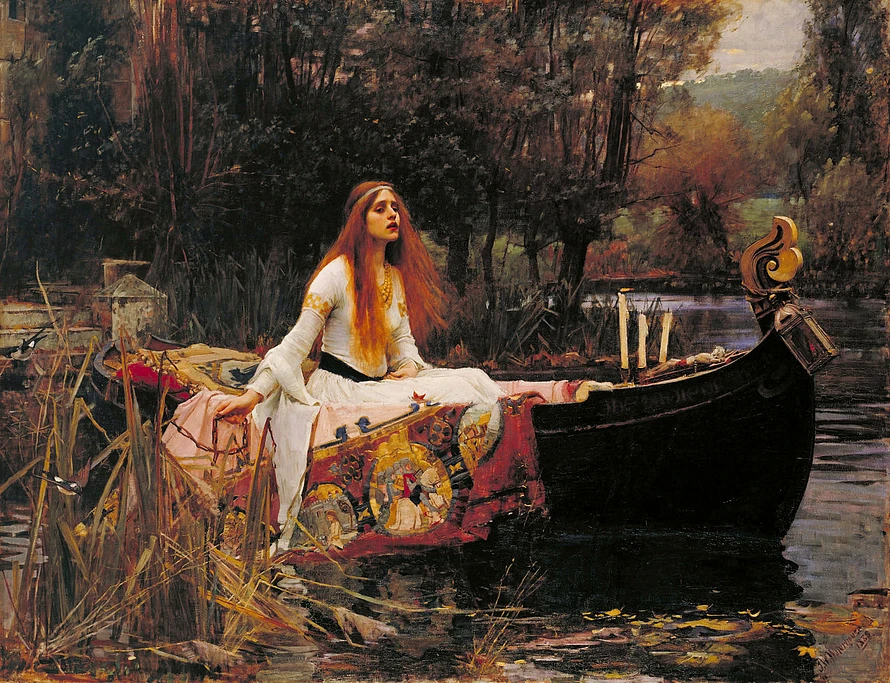The Lady of Shalott: Exploring Tennyson’s Poem and Waterhouse’s Iconic Painting
Discover the tragic beauty of The Lady of Shalott through Alfred Lord Tennyson’s poem and John William Waterhouse’s renowned painting. Explore the symbolism, story, and artistic legacy behind this masterpiece.
The Lady of Shalott: A Timeless Tale of Art and Tragedy
One of the most haunting and enduring figures in Victorian art and literature is The Lady of Shalott. Originally brought to life in the 1832 poem by Alfred Lord Tennyson, and later immortalized in the 1888 painting by John William Waterhouse, this tragic heroine continues to captivate audiences with her story of beauty, isolation, and doomed love.
Tennyson’s Poem: A Spellbound Maiden in a Tower
Alfred Lord Tennyson’s The Lady of Shalott is inspired by the Arthurian legends, particularly the story of Elaine of Astolat. In the poem, the Lady is cursed to live alone in a tower near Camelot, weaving a tapestry of the outside world that she sees only through a mirror. Forbidden to look directly at reality, she lives in shadow—until one day she glimpses the knight Sir Lancelot and dares to defy the curse.
Her decision leads her to leave the tower, set out on a boat, and sail to Camelot—where she dies before reaching her destination. The poem is rich with themes of artistic isolation, romantic yearning, and the conflict between reality and illusion.
Waterhouse’s 1888 Painting: Capturing the Moment of Departure
John William Waterhouse, a renowned Pre-Raphaelite painter, brought Tennyson’s poem vividly to life in his 1888 oil painting The Lady of Shalott. This masterpiece focuses on the climactic moment when the Lady sets out in a boat toward Camelot, fully aware of her doomed fate.
The painting is a masterclass in emotion and symbolism:
-
The Lady’s expression is a poignant mix of sorrow and resignation.
-
The tapestry draped over the boat symbolizes her life’s work.
-
Candles placed in the boat evoke the flickering nature of life—two extinguished, one still burning.
-
Natural elements like the dark water and autumnal foliage enhance the mood of melancholy and foreboding.
Waterhouse’s use of rich, earthy colors and intricate detail has made this painting one of the most beloved representations of Tennyson’s poem.
Symbolism and Themes: Art, Love, and Loss
Both the poem and the painting explore timeless themes:
-
The price of self-expression: The Lady’s death can be seen as the cost of breaking free from isolation to engage with the world.
-
The illusion of reality: The mirror and tapestry serve as metaphors for artistic representation, filtered and indirect.
-
Unattainable love: Sir Lancelot represents the ideal that ultimately leads to the Lady’s downfall.
These themes resonate with audiences across centuries, particularly those interested in the tension between creative life and real-world engagement.
The Legacy of The Lady of Shalott
Tennyson’s poem and Waterhouse’s painting continue to inspire artists, writers, and fans of Romantic and Gothic literature. The image of the Lady adrift on her final journey speaks to our deep human yearning—for connection, for beauty, and for meaning beyond isolation.
The painting has found a permanent home at the Tate Britain gallery in London, where it remains a highlight for art lovers around the world.
Why It Still Matters Today
In an age where many grapple with isolation—be it digital, emotional, or societal—the story of The Lady of Shalott remains as relevant as ever. It reminds us of the fragile line between the safety of solitude and the peril of truly living.
Conclusion
The union of Alfred Lord Tennyson’s lyrical genius and John William Waterhouse’s visual storytelling offers a profound meditation on love, loss, and the pursuit of beauty. Whether you’re an art enthusiast, literature lover, or someone exploring classic works for the first time, The Lady of Shalott stands as a symbol of timeless emotional power.
Get a Lady of Shalott Phone Case HERE
